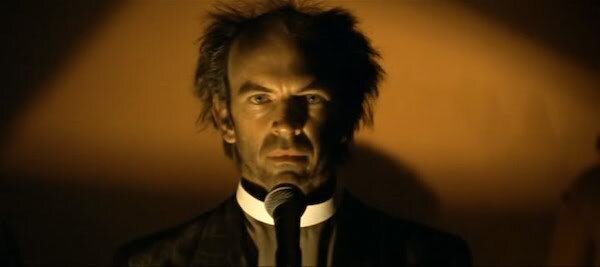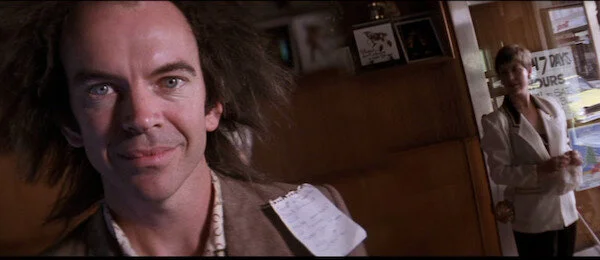Five Fun Facts About Bad Boy Bubby
Bad Boy Bubby is not for the faint of heart. Since its release in 1993, this twisted, provocative black comedy has repulsed and repelled many viewers away (including British film critic Mark Kermode who famously stormed out of a screening) — but it also continues to bewitch adventurous cinephiles and general weirdos to this day! We think writer/director Rolf de Heer said it best at the 21st anniversary screening at the 2015 Adelaide Film Festival:
"It's startling to think that twenty-two years after 'Bad Boy Bubby' confounded everyone, including me, by winning five prizes at the Venice Film Festival, and twenty-one years after it was released to an unsuspecting general public, the film is still ticking away, being shown, being seen, being loved and loathed in probable equal measure."
Love it or hate it, it’s an undeniable one-of-a-kind rollercoaster ride that can’t be unseen, and it’s one of our personal favorites (although one that’s extremely tough to recommend). This coming-of-age odyssey about a 35-year-old manchild who’s never set foot outside his mother’s dank and dingy apartment is a complete deconstruction of authority, from parental figures to police and political correctness to religion. Today, we celebrate this excellently provocative black comedy by tossing out some fun facts about the film and its production!
The screenplay took 10 years to complete.
Rolf de Heer wrote and developed the screenplay on and off for ten years before he finally go around to filming it. He started working on it shortly after he graduated film school, and for most of the 1980s, he collected ideas that he wrote on index cards. Around ‘89-’90, de Heer saw a short film called Confessor Caressor, which featured actor Nicholas Hope. He was so taken with Hope’s performance that he tracked him down. After Hope was on board, de Heer began working on an actual shooting script.
The film shoot was as unconventional as its story.
Bad Boy Bubby was shot entirely in sequence, and it used a staggering 31 different directors of photography to shoot the film. Shooting in sequence allowed Hope to mimic previous characters’ dialogue and organically build upon Bubby’s experiences. Rolf de Heer decided to use different DoPs to give the film an experimental feel and make all of Bubby’s experiences visually unique. After Bubby leaves his mom’s dingy apartment, a new DoP was brought in for each new scene until about the last third of the film. To make sure each scene was visually unique as possible, de Heer refused to let any of them refer to a previous DoP’s work.
The innovative sound design added an extra layer of perspective.
The sound crew sewed binaural microphones (two microphones, arranged with the intent to create a 3-D stereo sound sensation for the listener of actually being in the room) into the wig that Nicholas Hope wore, one above each ear. This approach gave the sound design an immersive feel, planting the view in Bubby’s perspective, resembling (as closely as possible) what Bubby would actually be hearing.
A bit of background on the treatment of cats in the film.
The film got in some hot water with animal rights groups when it was released in Italy (and it continues to outrage audiences everywhere for its depiction of animal violence and distress). Italy threatened to boycott Australian goods because they thought Bubby’s pet cat was actually suffocated with cling wrap (like it appeared to have been in the film). However, both Rolf de Heer and Nicholas Hope are on record stating that no animals were inhumanely treated during the production.
The scenes that give the illusion of animal abuse were filmed very carefully, with a veterinarian and animal cruelty inspection on set to ensure the animal’s safety. For Bubby’s pet cat, they used a feral cat. When Bubby accidentally kills it with cling wrap in the film, the on-set vet humanely put the feral cat down — as is the custom for feral cats in Australia when they’re captured. The cat’s corpse was used after it had been put to sleep, which is why the scene feels so uncomfortable and real, but it wasn’t tortured or abused in any way.
The kitten that gets “killed” later in the film wasn’t a feral cat. What you see in the scene isn’t a corpse; the cat had only been sedated with a tranquilizer, which allowed its body to go limp.
It was the film’s apparent animal abuse that caused Mark Kemode to leave a screening (ironic because he loves Cannibal Holocaust). While the cats weren’t harmed on-screen, the roaches totally were. Nicholas Hope definitely really ate that thing!
There was almost another ending.
When they were making the film, there was a rumor going around that Australia was going to reintroduce the death penalty, which greatly aggravated de Heer. He was so fired up, he rewrote the film’s ending so that Bubby would be executed at the end of the film. However, once the rumor turned out to be false, it was scrapped in favor of the original ending that gives Bubby a warm, sweet send off.
What do you think? We want to know. Share your thoughts and feelings in the comments section below, and as always, remember to viddy well!






